Assessment of Grassland Ecosystem Service Value in Response to Climate Change in China
Abstract
:1. Introduction
2. Materials and Methods
2.1. Study Area
2.2. ESV Evaluation Method
2.2.1. Model and Index System
2.2.2. Assumptions
2.3. NPP Evaluation
2.4. Data Sources and Processing
2.4.1. Used Data
2.4.2. Data Analysis
3. Results
3.1. The Temporal Distribution of Grassland ESV
3.2. The Spatial Distribution of Grassland ESV
3.3. The Relationship of Ecosystem Service Value and Climatic Factors
4. Discussion
4.1. Quantity and Evolution Characteristics of ESVs
4.2. Key Climatic Controlling Factors
4.3. Limitations
5. Conclusions
- (1)
- From 2001 to 2020, the average annual grassland ESV in China was 1.37 × 1012 yuan ($0.18 × 1012). The ESV per unit area of grassland increased from northwest to southeast. However, the grassland ESV in northern and western provinces of China was relatively higher and the highest values were more than 10 × 106 yuan ($1.30 × 106).
- (2)
- In most grassland areas, ESV has shown an increasing trend in the past 20 years. At the same time, the mean annual ESV was higher (usually less than 20%) in the last 10 years than in the first 10 years. By contrast, ESV has decreased in some grassland areas of Tibet Province and Xinjiang Province.
- (3)
- With regard to the four major ecosystem services, regulation service accounted for the largest proportion of 52.6% (0.721 × 1012 yuan; $938.80 × 108), followed by supporting (42%, 0.575 × 1012 yuan; $748.70 × 108), provision (4.8%, 0.066 × 1012 yuan; $85.94 × 108), and cultural (0.6%, 0.008 × 1012 yuan; $10.42 × 108) services.
- (4)
- Precipitation was the main regulator of grassland ESV across the 20-year period. It had a positive effect on ESV in 79% of grassland areas. The ESV of grassland was affected by evapotranspiration and sunshine hours to a certain extent, but not by temperature and relative humidity.
Author Contributions
Funding
Institutional Review Board Statement
Informed Consent Statement
Data Availability Statement
Acknowledgments
Conflicts of Interest
References
- Costanza, R.; d’Arge, R.; de Groot, R.; Farber, S.; Grasso, M.; Hannon, B.; Limburg, K.; Naeem, S.; O’Neill, R.V.; Paruelo, J.; et al. The value of the world’s ecosystem services and natural capital. World Environ. 1997, 387, 3–15. [Google Scholar] [CrossRef]
- Millennium Ecosystem Assessment. Ecosystems and Human Well-Being: Synthesis; Island Press: Washington, DC, USA, 2005; p. 137. [Google Scholar]
- Haines, Y.R.; Potschin, M. Common International Classification of Ecosystem Services (CICES): 2011 Update; University of Nottingham: Nottingham, UK, 2011; pp. 1–13. [Google Scholar]
- Haines, Y.R.; Potschin, M. Common International Classification of Ecosystem Services (CICES, Version 4.1); European Environment Agency: Copenhagen, Denmark, 2012; pp. 1–17.
- Costanza, R.; de Groot, R.; Sutton, P.; van der Ploeg, S.; Anderson, S.J.; Kubiszewski, I.; Farber, S.; Turner, R.K. Changes in the global value of ecosystem services. Glob. Environ. Chang. 2014, 26, 152–158. [Google Scholar] [CrossRef]
- Cowie, A.L.; Orr, B.J.; Sanchez, V.M.C.; Chasek, P.; Crossman, N.D.; Erlewein, A.; Louwagie, G.; Cumming, G.S.; Buerkert, A.; Hoffmann, E.M.; et al. Implications of agricultural transitions and urbanization for ecosystem services. Nature 2014, 515, 50–57. [Google Scholar] [CrossRef]
- Schaller, L.; Targetti, S.; Villanueva, A.J.; Zasada, I.; Viaggi, D. Agricultural landscapes, ecosystem services, and regional competitiveness-assessing drivers and mechanisms in nine European case study areas. Land Use Policy 2018, 76, 735–745. [Google Scholar] [CrossRef]
- Chen, J.; Jiang, B.; Bai, Y.; Xu, X.; Alatalo, J.M. Quantifying ecosystem services supply and demand shortfalls and mismatches for management optimisation. Sci. Total Environ. 2019, 650, 1426–1439. [Google Scholar] [CrossRef]
- IPCC. Climate Change 2014: Impacts, Adaptation, and Vulnerability. Part A: Global and Sectoral Aspects; Contribution of Working Group II to the Fifth Assessment Report of the Intergovernmental Panel on Climate Change; Field, C.B., Barros, V., Mastrandrea, M.D., Mach, K.J., Abdrabo, M., Adger, W.N., Anokhin, Y.A., Anisimov, O.A., Arent, D., Barnett, J., et al., Eds.; Cambridge University Press: Cambridge, UK, 2014; p. 1132.
- Lyu, R.; Clarke, K.C.; Zhang, J.; Feng, J.; Jia, X.; Li, J. Spatial correlations among ecosystem services and their socio-ecological driving factors: A case study in the city belt along the Yellow River in Ningxia, China. Appl. Geogr. 2019, 108, 64–73. [Google Scholar] [CrossRef] [Green Version]
- Li, G.; Ren, H. Biomass and net primary productivity of the forests in different climatic zones of china. Trop. Geogr. 2004, 24, 306–310. (In Chinese) [Google Scholar] [CrossRef] [Green Version]
- Xu, Y.; Yu, L.; Zhou, B.; Shi, Y.; Xu, Y. Temporal-spatial dynamic pattern of grassland ecosystem service value under the background of climate change in the future in China. Ecol. Environ. Sci. 2017, 26, 1649–1658. (In Chinese) [Google Scholar]
- Han, X.; Yu, J.; Shi, L.; Zhao, X.; Wang, J. Spatiotemporal evolution of ecosystem service values in an area dominated by vegetation restoration: Quantification and mechanisms. Ecol. Indic. 2021, 131, 108191. [Google Scholar] [CrossRef]
- Schirpke, U.; Kohler, M.; Leitinger, G.; Fontana, V.; Tasser, E.; Tappeiner, U. Future impacts of changing land-use and climate on ecosystem services of mountain grassland and their resilience. Ecosyst. Serv. 2017, 26, 79–94. [Google Scholar] [CrossRef]
- Zhou, H.; Zhao, X.; Tang, Y.; Gu, S.; Zhou, L. Alpine grassland degradation and its control in the source region of the Yangtze and Yellow Rivers, China. Grassl. Sci. 2005, 51, 191–203. [Google Scholar] [CrossRef]
- Yang, Q.; Liu, G.; Giannetti, B.G.; Agostinho, F.; Cecília, M.V.B.; Casazzad, M.C. Emergy-based ecosystem services valuation and classification management applied to China’s grasslands. Ecosyst. Serv. 2020, 42, 101073. [Google Scholar] [CrossRef]
- Zheng, X.; Zhang, J. Net value of grassland ecosystem services in mainland China. Land Use Policy 2018, 79, 94–101. [Google Scholar] [CrossRef]
- Harris, R.B. Rangeland degradation on the Qinghai-Tibetan plateau: A review of the evidence of its magnitude and causes. J. Arid Environ. 2010, 74, 1–12. [Google Scholar] [CrossRef]
- Seto, K.C.; Michail, F.; Burak, G.; Reilly, M.K. A meta-analysis of global urban land expansion. PLoS ONE 2011, 6, e23777. [Google Scholar] [CrossRef]
- Gang, C.; Zhou, W.; Chen, Y.; Wang, Z.; Sun, Z.; Li, J.; Qi, J.; Odeh, I. Quantitative assessment of the contribution of climate change and human activities on global grassland degradation. Environ. Earth Sci. 2014, 72, 4273–4282. [Google Scholar] [CrossRef]
- Wang, Z.; Deng, X.; Song, W.; Li, Z.; Chen, J. What is the main cause of grassland degradation? A case study of grassland ecosystem service in the middle-south Inner Mongolia. Catena 2017, 150, 100–107. [Google Scholar] [CrossRef]
- Bao, W.; Shan, W.; Yang, X.; Song, H.; Lan, Y. Ecological crises facing the grassland resources in northern China and their solutions. Grassl. China 1998, 20, 68–71. [Google Scholar]
- Nan, Z. The grassland farming system and sustainable agricultural development in China. Grassl. Sci. 2010, 51, 15–19. [Google Scholar] [CrossRef]
- Feng, C.; Ye, S.; Diao, Z.; Lü, S. Ecological pressures on grassland ecosystems and their conservation strategies in Northern China AU-Zheng, Zhirong. Chin. J. Popul. Resour. Environ. 2015, 13, 87–91. [Google Scholar]
- Runting, R.K.; Bryan, B.A.; Dee, L.E.; Maseyk, F.J.; Mandle, L.; Hamel, P.; Wilson, K.A.; Yetka, K.; Possingham, H.P.; Rhodes, J.R. Incorporating climate change into ecosystem service assessments and decisions: A review. Glob. Chang. Biol. 2017, 23, 28–41. [Google Scholar] [CrossRef] [Green Version]
- Staudinger, M.D.; Grimm, N.B.; Staudt, A.; Carter, S.L.; Chapin, F.S. Impacts of Climate Change on Biodiversity, Ecosystems, and EcoSystem Services; United States Global Change Research Progra: Washington, DC, USA, 2012; p. 296.
- Dow, K.; Berkhout, F.; Preston, B.L.; Klein, R.J.T.; Midgley, G.; Shaw, M.R. Limits to adaptation. Nat. Clim. Chang. 2013, 3, 305–307. [Google Scholar] [CrossRef]
- Nelson, E.J.; Kareiva, P.; Ruckelshaus, M.; Arkema, K.; Geller, G.; Girvetz, E.; Tallis, H. Climate change’s impact on key ecosystem services and the human well-being they support in the US. Front. Ecol. Environ. 2013, 11, 483–493. [Google Scholar] [CrossRef] [Green Version]
- Schäfer, L.; Warner, K.; Kreft, S. Exploring and Managing Adaptation Frontiers with Climate Risk Insurance; Mechler, R., Bouwer, L.M., Schinko, T., Surminski, S., Linnerooth-Bayer, J., Eds.; Springer Open: Berlin/Heidelberg, Germany, 2018; pp. 317–341. [Google Scholar] [CrossRef] [Green Version]
- Augustynczik, A.L.D.; Yousefpour, R. Assessing the synergistic value of ecosystem services in European beech forests. Ecosyst. Serv. 2021, 49, 101264. [Google Scholar] [CrossRef]
- Lamarque, P.; Lavorel, S.; Mouchet, M.; Quetier, F. Plant trait-based models identify direct and indirect effects of climate change on bundles of grassland ecosystem services. Proc. Natl. Acad. Sci. USA 2014, 111, 13751–13756. [Google Scholar] [CrossRef] [Green Version]
- Wang, T.; Wu, W.; Xue, X.; Sun, Q.; Chen, G. Study of spatial distribution of sandy desertification in North China in recent 10 years. Sci. China J. Earth Sci. 2004, 47, 78–88. [Google Scholar] [CrossRef]
- Qiu, L.; Hao, M.; Wu, Y. Potential impacts of climate change on carbon dynamics in a rain-fed agro-ecosystem on the Loess Plateau of China. Sci. Total Environ. 2016, 577, 267–278. [Google Scholar] [CrossRef]
- Gong, S.; Xiao, Y.; Xiao, Y.; Zhang, L.; Ouyang, Z. Driving forces and their effects on water conservation services in forest ecosystems in China. Chin. Geogr. Sci. 2017, 27, 216–228. [Google Scholar] [CrossRef] [Green Version]
- Cui, F.; Wang, B.; Zhang, Q.; Tang, H.; de Maeyer, P.; Hamdi, R.; Dai, L. Climate change versus land-use change—What affects the ecosystem services more in the forest-steppe ecotone? Sci. Total Environ. 2021, 759, 143525. [Google Scholar] [CrossRef]
- Schultner, J.; Dorresteijn, I.; Manlosa, A.O.; von Wehrden, H.; Hylander, K.; Senbeta, F.; Fischer, J. Ecosystem services from forest and farmland: Present and past access separates beneficiaries in rural Ethiopia. Ecosyst. Serv. 2021, 48, 101263. [Google Scholar] [CrossRef]
- National Animal Husbandry and Veterinary Station; Department of Veterinary Medicine; Ministry of Agriculture People’s Republic of China. Grassland Resources in China; Science and Technology of China Press: Beijing, China, 1996; p. 608. (In Chinese)
- Xu, X.; Liu, J.; Zhang, S.; Li, R.; Yan, C.; Wu, S. China Many Periods of Land Use Land Cover Remote Sensing Monitoring Data Set (CNLUCC), Chinese Academy of Sciences, Resources and Environment Science Data Center Data Registration and Publication System. 2018. (In Chinese). Available online: http://www.resdc.cn/DOI (accessed on 1 May 2021). [CrossRef]
- Xie, G.; Zhen, L.; Lu, C. Expert knowledge based valuation method of ecosystem services in China. J. Nat. Resour. 2008, 23, 911–919. (In Chinese) [Google Scholar]
- Xie, G.; Lu, C.; Zheng, D.; Li, S. Ecological assets valuation of the Tibetan Plateau. J. Nat. Resour. 2003, 18, 189–196. (In Chinese) [Google Scholar]
- Fang, J.; Yang, Y.; Ma, W.; Anivar, M.; Shen, H. Ecosystem carbon stocks and their changes in China’s grasslands. Sci. China Life Sci. 2010, 53, 757–765. [Google Scholar] [CrossRef]
- Piao, S.; Fang, J. Dynamic vegetation cover change over the last 18 years in China. Quat. Sci. 2001, 21, 94–302. (In Chinese) [Google Scholar]
- Yang, Y.; Fang, J.; Ma, W.H.; Guo, D.; Mohammat, A. Large-scale pattern of biomass partitioning across China’s grasslands. Glob. Ecol. Biogeogr. 2010, 19, 268–277. [Google Scholar] [CrossRef]
- Fang, J.Y.; Liu, G.H.; Xu, S.L. Carbon storage in terrestrial ecosystem of China. In The Measurement of Greenhouse Gas and Their Release and Related Processes; Wang, G.C., Wen, Y.P., Eds.; China Environmental Science Press: Beijing, China, 1996; pp. 391–397. (In Chinese) [Google Scholar]
- Huang, L.; Zhai, J.; Zhu, P.; Zheng, Y. Spatiotemporal evolution characteristics of livestock-carrying pressure in China and its implications for grassland ecosystem conservation pattern. Acta Geogr. Sin. 2020, 75, 2396–2407. [Google Scholar]
- Xie, G.; Zhang, C.; Zhen, L.; Chen, W.; Li, S.; Zhang, L. Improvement of the evaluation method for ecosystem service value based on per unit area. J. Nat. Resour. 2015, 30, 1243–1254. (In Chinese) [Google Scholar]
- Potter, C.S.; Randerson, J.T.; Field, C.B.; Matson, P.A.; Vitousek, P.M.; Mooney, H.A.; Klooster, S.A. Terrestrial ecosystem production: A process model based on global satellite and surface data. Glob. Biogeochem. Cycles 1993, 7, 811–841. [Google Scholar] [CrossRef]
- Luo, Q.; Zhou, J.; Li, Z.; Yu, B. Spatial differences of ecosystem services and their driving factors: A comparation analysis among three urban agglomerations in China’s Yangtze River Economic Belt. Sci. Total Environ. 2020, 725, 138452. [Google Scholar] [CrossRef]
- Zhang, Y.; Lu, X.; Liu, B.; Wue, D.; Fu, G.; Zhao, Y.; Sun, P. Spatial relationships between ecosystem services and socioecological drivers across a large-scale region: A case study in the Yellow River Basin. Sci. Total Environ. 2021, 766, 142480. [Google Scholar] [CrossRef]
- Xie, G.; Zhen, L.; Lu, C.; Xiao, Y.; Li, W. Applying value transfer method for eco-service valuation in China. J. Resour. Ecol. 2010, 1, 51–59. [Google Scholar]
- Liu, Y.; Ren, H.; Zhou, R.; Basang, C.; Zhang, W.; Zhang, Z.; Wen, Z. Estimation and dynamic analysis of the service value of grassland ecosystem in China. Acta Agrestia Sin. 2021, 29, 1522–1532. [Google Scholar]
- Zhao, T.; Ouyang, Z.; Jia, L. Ecosystem services and their valuation of China grassland. Acta Ecol. Sin. 2004, 24, 1101–1110. (In Chinese) [Google Scholar]
- Xie, G.; Zhang, Y.; Lu, C.; Zheng, D.; Cheng, S. Ecosystem service value of natural grassland in China. J. Nat. Resour. 2001, 16, 47–53. (In Chinese) [Google Scholar]
- Chen, Z.; Zhang, X. The value of ecosystem benefits in China. Chin. Sci. Bull. 2000, 45, 17–22. (In Chinese) [Google Scholar]
- Wang, R.; Qin, Z. Valuation of Chinese grassland ecosystem services using MODIS data. Chin. J. Grassl. 2007, 9, 50–53. (In Chinese) [Google Scholar]
- Jiang, L.; Qin, Z.; Xie, W. Estimation of Grassland ecosystem services value of china using remote sensing data. J. Nat. Resour. 2007, 22, 161–169. (In Chinese) [Google Scholar]
- Roch, L.; Jaeger, J.A.G. Monitoring an ecosystem at risk: What is the degree of grassland fragmentation in the Canadian Prairies? Environ. Monit. Assess. 2014, 186, 2505–2534. [Google Scholar] [CrossRef]
- Kang, L.; Han, X.G.; Zhang, Z.B.; Sun, O.J. Grassland ecosystems in China: Review of current knowledge and research advancement. Philos. Trans. R. Soc. B Biol. Sci. 2007, 362, 997–1008. [Google Scholar] [CrossRef]
- Xu, Y.; Xiao, F.; Yu, L. Review of spatio—Temporal distribution of net primary productity in forest ecosystem and its responses to climate change in China. Acta Ecol. Sin. 2020, 40, 4710–4723. (In Chinese) [Google Scholar]
- Xie, G.; Zhang, C.; Zhen, L.; Zhang, L. Dynamic changes in the value of China’s ecosystem services. Ecosyst. Serv. 2017, 26, 146–154. [Google Scholar] [CrossRef]
- Wang, Y.; Dai, E.; Yin, L.; Ma, L. Land use/land cover change and the effects on ecosystem services in the Hengduan Mountain region China. Ecosyst. Serv. 2018, 34, 55–67. [Google Scholar] [CrossRef]
- Xu, D.; Ding, X. Assessing the impact of desertification dynamics on regional ecosystem service value in North China from 1981 to 2010. Ecosyst. Serv. 2018, 30, 172–180. [Google Scholar] [CrossRef]
- Li, S.; Bing, Z.; Jin, G. Spatially explicit mapping of soil conservation service in monetary units due to land use/cover change for the Three Gorges Reservoir Area, China. Remote Sens. 2019, 11, 468. [Google Scholar] [CrossRef] [Green Version]
- Chen, T.; Feng, Z.; Zhao, H.; Wu, K. Identification of ecosystem service bundles and driving factors in Beijing and its surrounding areas. Sci. Total Environ. 2020, 711, 134687. [Google Scholar] [CrossRef]
- Kim, J.H.; Jobbagy, E.G.; Jackson, R.B. Trade-offs in water and carbon ecosystem services with land-use changes in grasslands. Ecol. Appl. 2016, 26, 2767. [Google Scholar] [CrossRef] [Green Version]
- Liu, J.; Zhang, Z.; Xu, X.; Kuang, W.; Zhou, W.; Zhang, S.; Li, R.; Yan, C.; Yu, D.; Wu, S. Spatial patterns and driving forces of land use change in China in the early 21st century. Acta Geograph. Sin. 2009, 64, 1411–1420. [Google Scholar] [CrossRef]
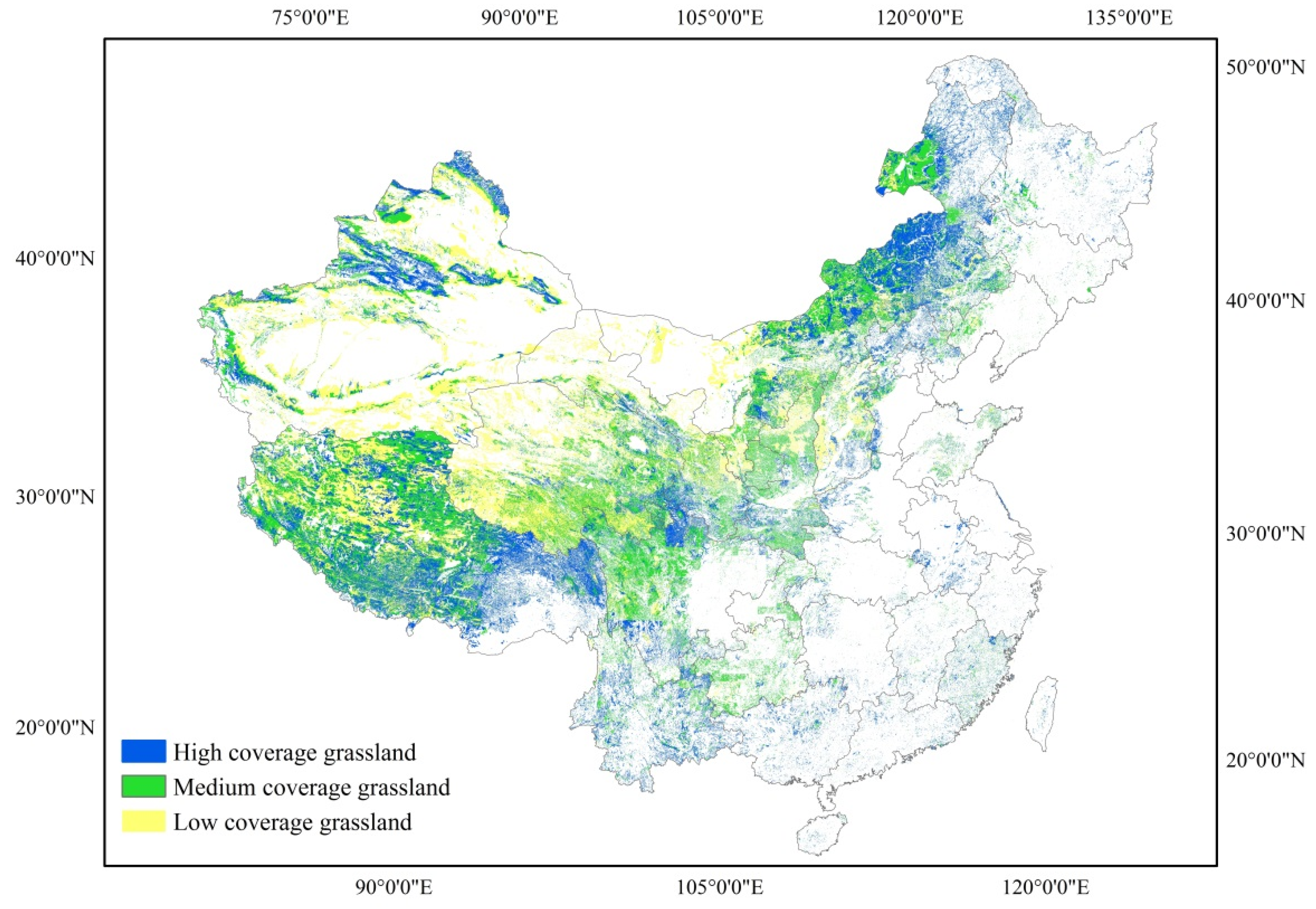
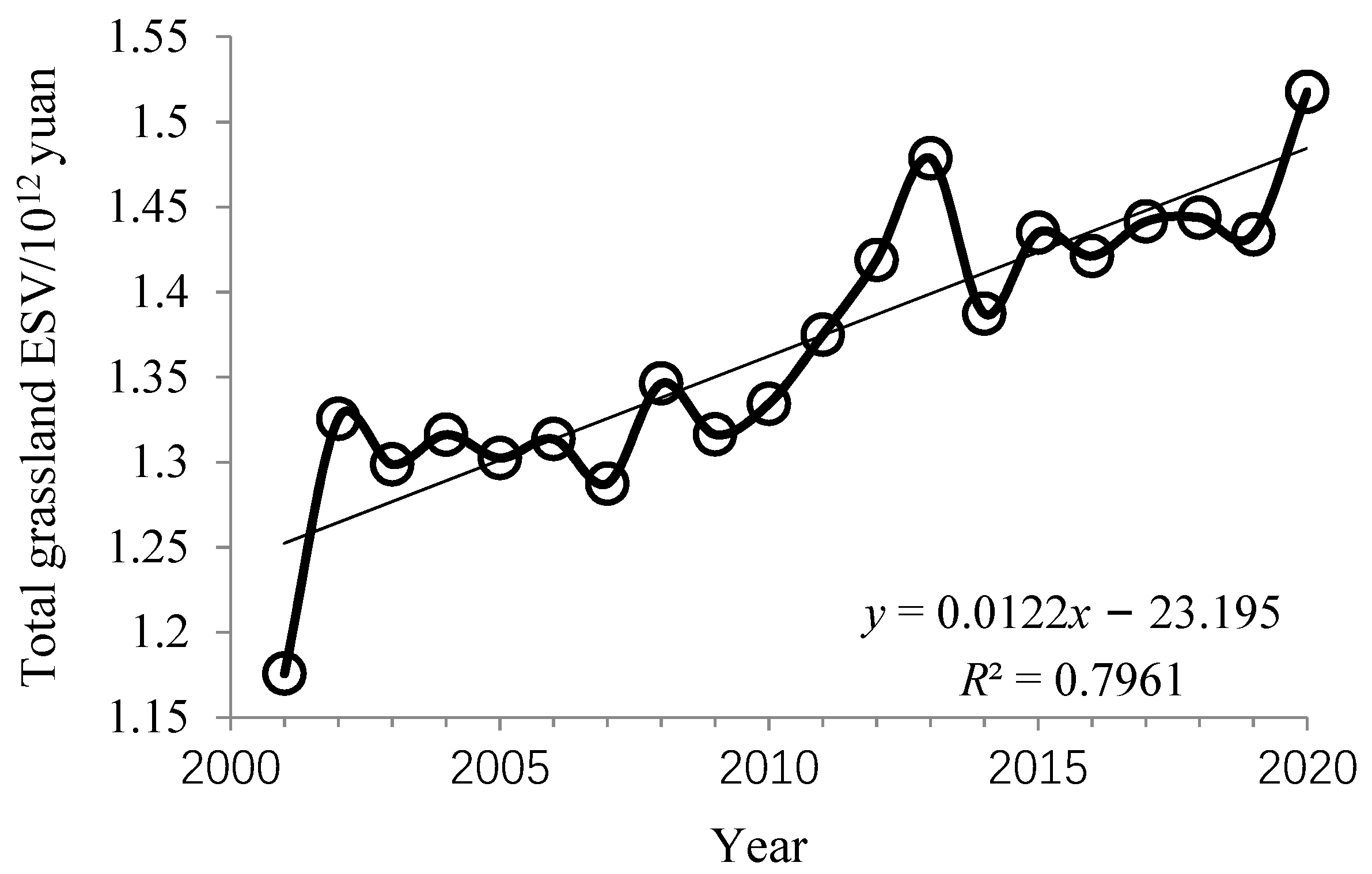
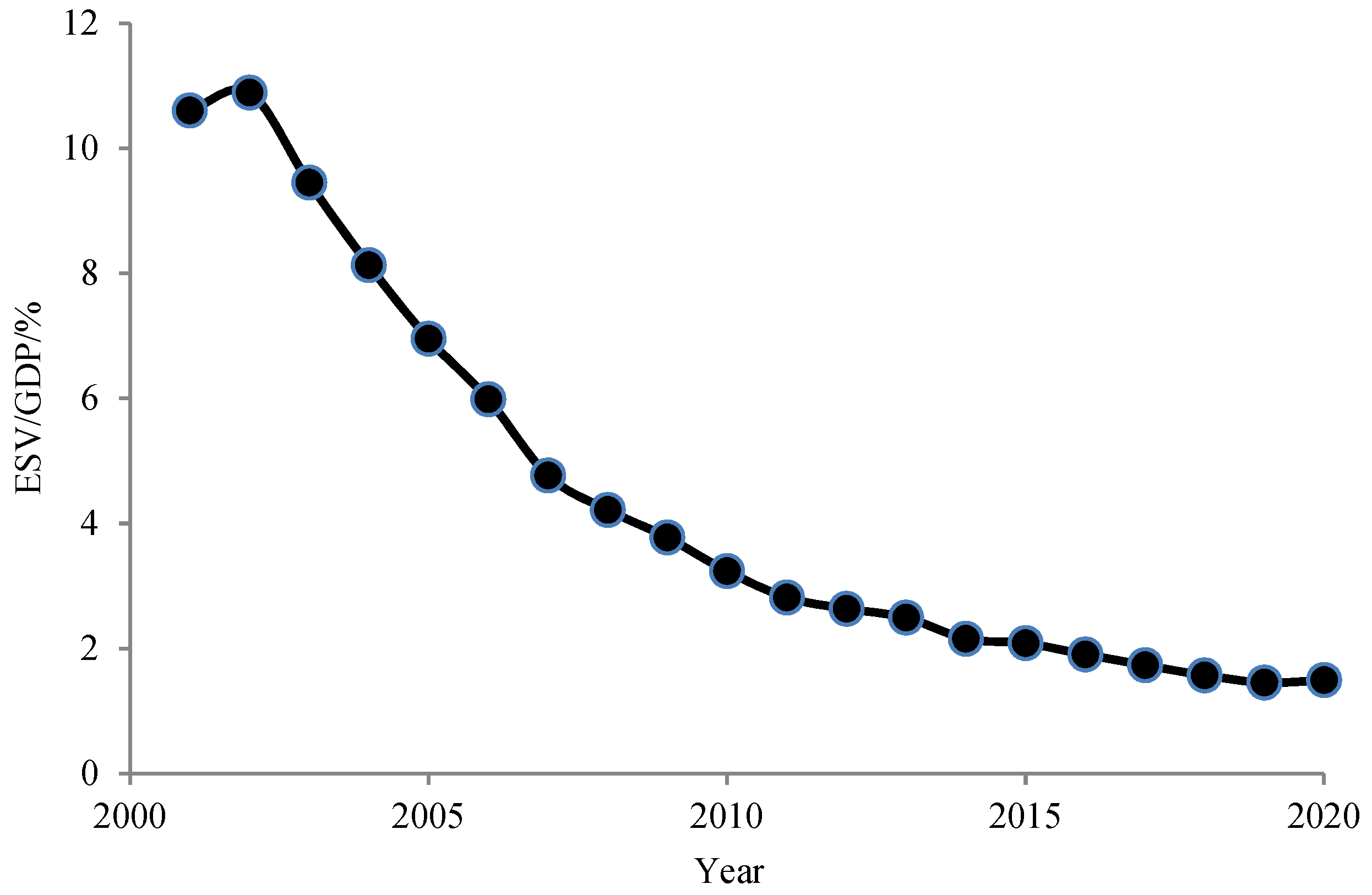
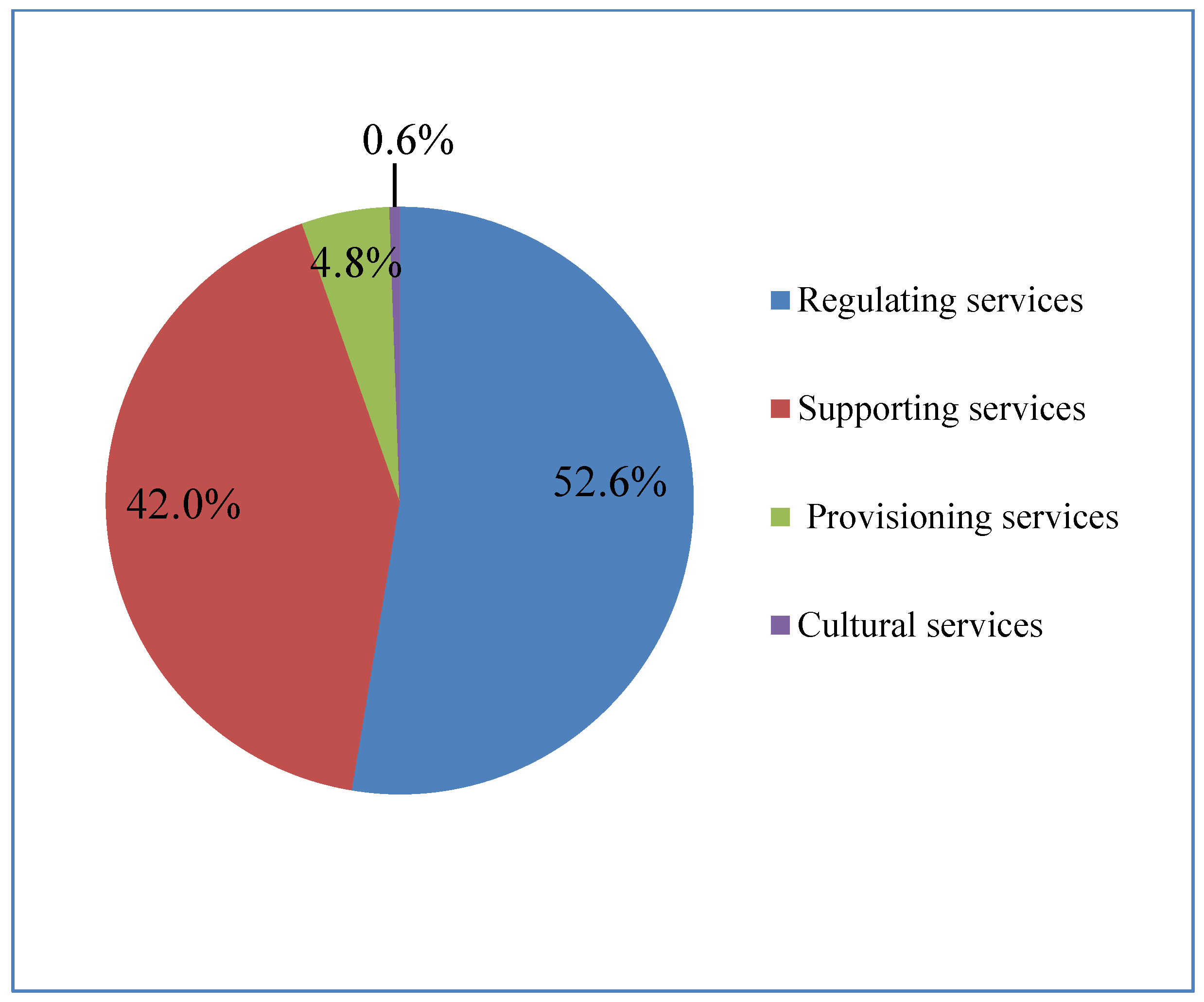

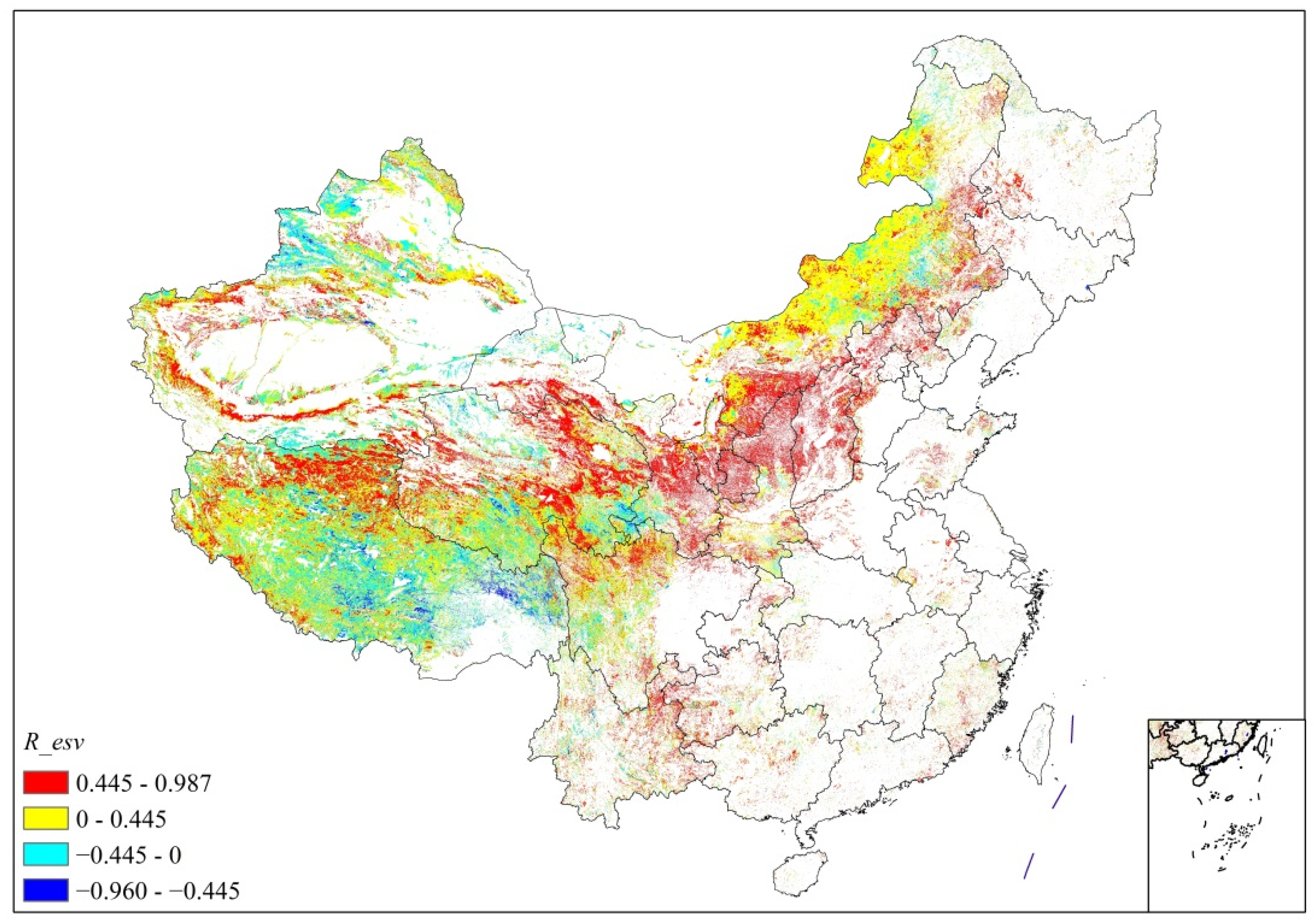
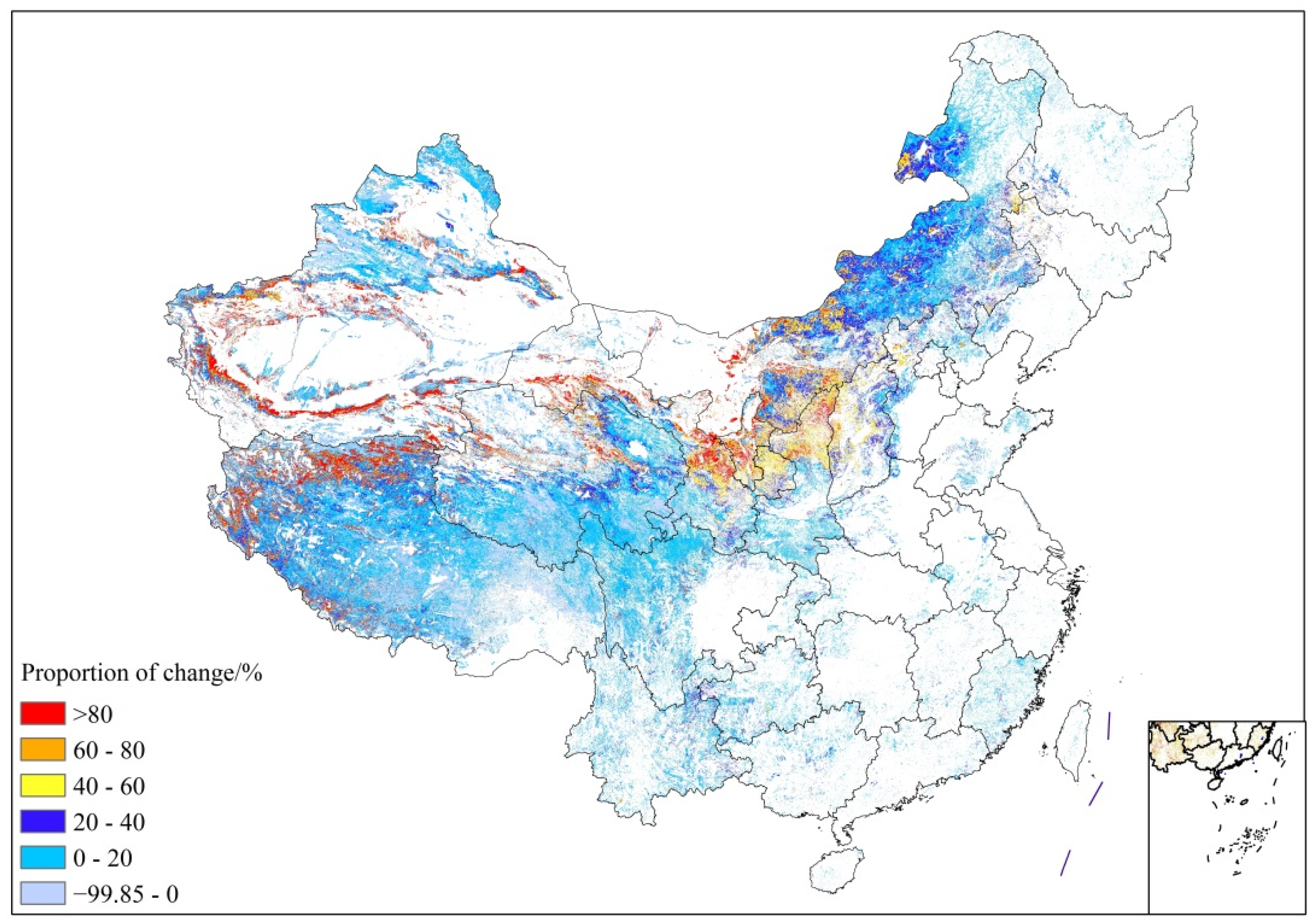
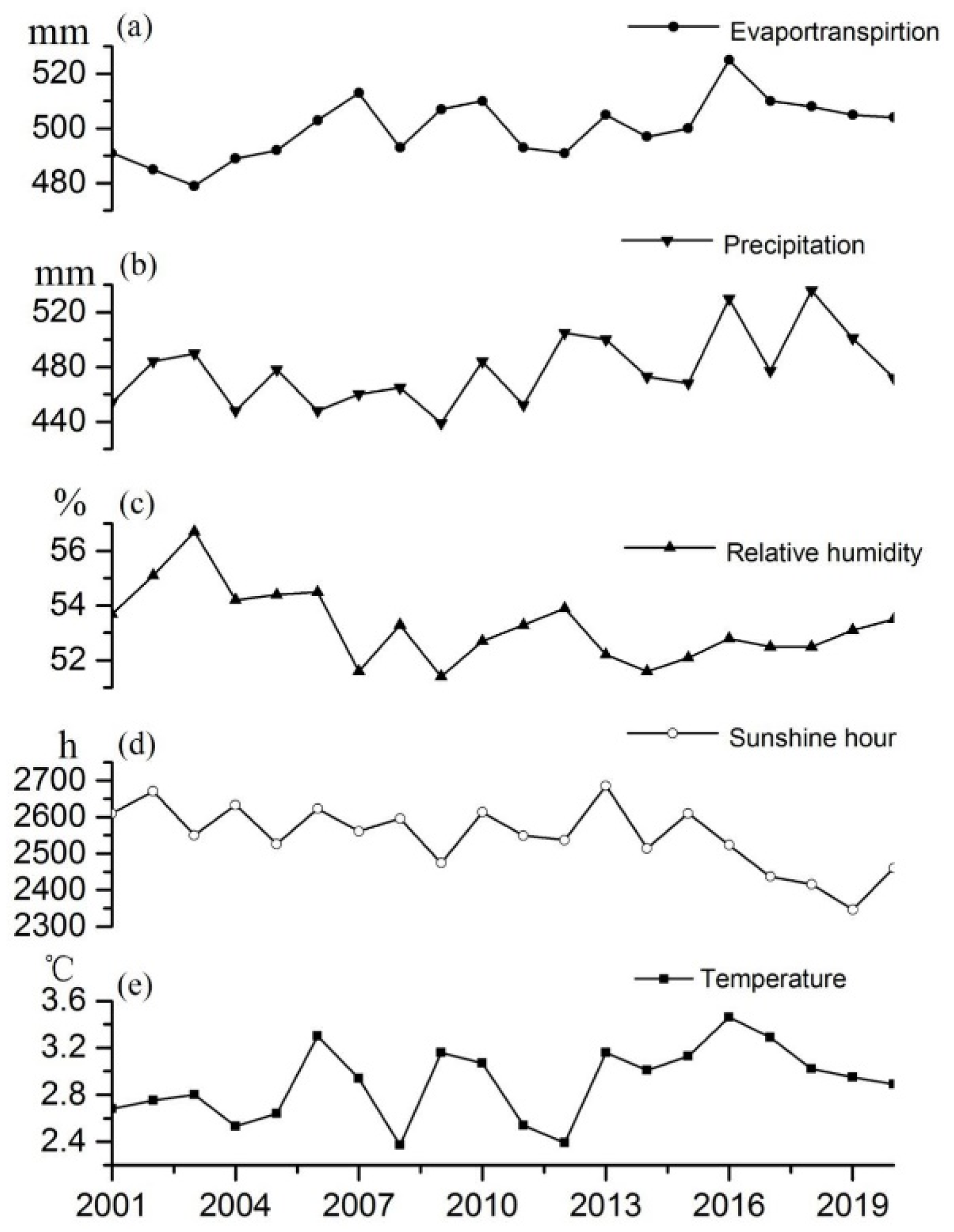
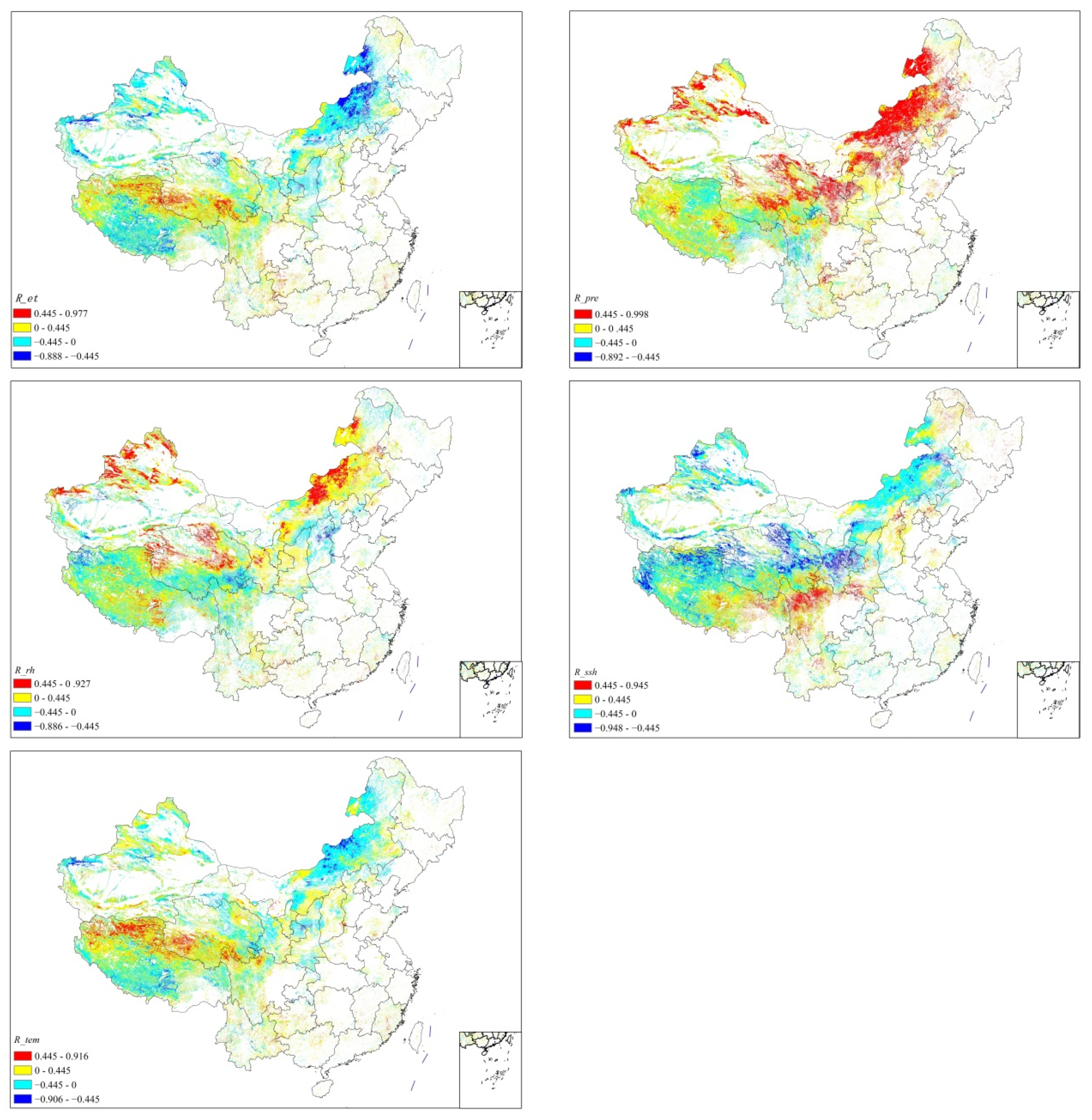
| Categories | Services Item (Sub-Categories) | Unit Price/yuan (pi) |
|---|---|---|
| Regulating service | Gas regulation | 707.9 |
| Climate regulation | 796.4 | |
| Supporting service | Water conservation | 707.9 |
| Soil formation and protection | 1725.5 | |
| Waste treatment | 1159.2 | |
| Biodiversity protection | 964.5 | |
| Provision service | Food production | 265.5 |
| Raw material production | 44.3 | |
| Cultural service | Recreation and culture | 35.4 |
| Model/Output | Input Data | Data Source |
|---|---|---|
| ESV | Unit price | Xie et al. (2003, 2008) [39,40] |
| Area | RESDC (Xu et al., 2018) [39] | |
| b | Fang et al. (1996) [44] | |
| B | Fang et al. (1996) [44] | |
| NPP | CASA (as follows) | |
| CASA/NPP | NDVI | The EOS/MODIS portal of NASA (https://ladsweb.modaps.eosdis.nasa.gov, accessed on 1 May 2021) |
| Climate data | Chinese Meteorological Information Center (http://cdc.cma.gov.cn, accessed on 1 July 2021) | |
| Land use type | RESDC (Xu et al., 2018) [38] |
| Province/City | ESV/104 yuan | Province/City | ESV/104 yuan |
|---|---|---|---|
| Hong Kong | 1 | Ningxia | 44 |
| Shanghai | 0 | Qinghai | 1369 |
| Hainan | 12 | Shaanxi | 561 |
| Guangxi | 203 | Henan | 60 |
| Guangdong | 74 | Shandong | 77 |
| Yunnan | 824 | Gansu | 555 |
| Guizhou | 259 | Shanxi | 247 |
| Fujian | 194 | Beijing | 10 |
| Hunan | 68 | Tianjin | 1 |
| Jiangxi | 63 | Hebei | 231 |
| Zhejiang | 19 | Liaoning | 62 |
| Chongqing | 65 | Jilin | 48 |
| Sichuan | 1284 | Inner Mongolia | 1847 |
| Hubei | 68 | Heilongjiang | 271 |
| Anhui | 81 | Xinjiang | 857 |
| Jiangsu | 6 | Taiwan | 13 |
| Tibet | 1303 |
| Studies | Currency Used for ESV | Evaluation Object | Calculation Method/Cited | ||
|---|---|---|---|---|---|
| yuan/1012 | US $/1012 | Value Grassland | |||
| Our study | 1.37 | 0.18 | Total | Total | Σ(ESVi per area × area)/Xie et al., 2008 [39] |
| Zhao et al., 2004 [52] | 0.88 | Indirect | Total | Σ(ESi × pricei)/a method cited for Each ES | |
| Xie et al., 2001 [53] | 0.15 | Total | Natural | Σ(ESVi per area × area)/Xie et al., 2001 [53] | |
| Chen et al., 2000 [54] | 0.87 | Total | Total | Σ(ESVi per area × area)/Costanza et al., 1997 [1] | |
| Wang et al., 2007 [55] | 0.03 | Total | Total | Σ(ESVi per area × area)/Revised from Xie et al., 2001 [53] | |
| Jiang et al., 2007 [56] | 1.7 | Total | Total | Σ(ESi × pricei)/a method cited for Each ES | |
| Xie et al., 2010 [50] | (0.87–7.5) | Total | Total | Survey and estimation | |
| Liu et al., 2021 [51] | 1.38 | Total | Total | Σ(ESi × pricei)/a method cited for Each ES | |
Publisher’s Note: MDPI stays neutral with regard to jurisdictional claims in published maps and institutional affiliations. |
© 2022 by the authors. Licensee MDPI, Basel, Switzerland. This article is an open access article distributed under the terms and conditions of the Creative Commons Attribution (CC BY) license (https://creativecommons.org/licenses/by/4.0/).
Share and Cite
Xu, Y.; Xiao, F.; Liao, Y. Assessment of Grassland Ecosystem Service Value in Response to Climate Change in China. Diversity 2022, 14, 160. https://doi.org/10.3390/d14030160
Xu Y, Xiao F, Liao Y. Assessment of Grassland Ecosystem Service Value in Response to Climate Change in China. Diversity. 2022; 14(3):160. https://doi.org/10.3390/d14030160
Chicago/Turabian StyleXu, Yuqing, Fengjin Xiao, and Yaoming Liao. 2022. "Assessment of Grassland Ecosystem Service Value in Response to Climate Change in China" Diversity 14, no. 3: 160. https://doi.org/10.3390/d14030160
APA StyleXu, Y., Xiao, F., & Liao, Y. (2022). Assessment of Grassland Ecosystem Service Value in Response to Climate Change in China. Diversity, 14(3), 160. https://doi.org/10.3390/d14030160






